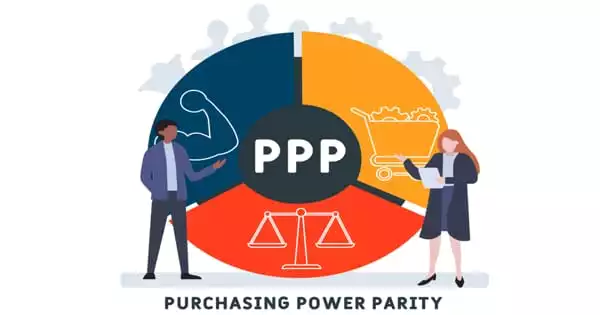The notion of Purchasing Power Parity (PPP) is a measure used to make multilateral comparisons between different countries’ national incomes and living standards. Purchasing power parity is a prominent macroeconomic study statistic for comparing economic productivity and living standards across countries (PPP). It is a method of comparing the absolute purchasing power of different currencies by comparing the costs of certain items in different nations. It is a prominent indicator used by macroeconomic researchers to compare the currencies of different countries using a “basket of products” methodology.
Purchasing power parity (PPP) allows economists to compare economic production and living standards across countries. In many circumstances, PPP generates an inflation rate equal to the price of a basket of products in one location divided by the price of a basket of goods in another area. To account for PPP, some countries modify their gross domestic product (GDP) figures. Because of poverty, tariffs, and other transaction expenses, PPP inflation and exchange rates may differ from market exchange rates.
Concept
Purchasing power parity is an economic concept used to compare pricing in different countries. It is based on the law of one price, which states that if there are no transaction costs or trade barriers for a specific commodity, the price for that good should be the same in all locations. A computer in New York and one in Hong Kong should ideally be the same price. If a computer costs $500 in New York and $2,000 in Hong Kong, PPP theory dictates that the exchange rate should be 4 HK dollars for every 1 US dollar.
The term purchasing power parity (PPP) refers to the calculation of the relative value of different currencies. Purchasing power parity, when used to calculate GDP per capita, provides a more realistic picture of a country’s total standard of life. Assume country A has a GDP per capita of $40,000, while country B has a GDP per capita of $10,000.
Does this imply that the inhabitants of country A are four times as wealthy? It is conditional. What if the cost of a basket of commodities, plus housing, utilities, transportation, and health care is four times more in nation A than in country B? The living standards in the two countries would be very comparable.
Because poverty, tariffs, transportation, and other frictions prohibit the selling and purchase of many items, measuring a single good can result in a big mistake. The PPP term accounts for this by referring to a basket of products, which consists of a variety of goods in varying quantities. PPP then calculates an inflation and exchange rate as the ratio of the basket’s price in one area to the basket’s price in the other location. For example, if a basket containing one computer, one ton of rice, and one ton of steel costs 1800 US dollars in New York and 10800 HK dollars in Hong Kong, the PPP exchange rate is six HK dollars for every one US dollar.
The term purchasing power parity refers to the assumption that, with the correct exchange rate, customers everywhere will have the same purchasing power. The PPP exchange rate’s value is highly reliant on the basket of products chosen. In general, commodities that closely follow the law of one price are picked. As a result, ones swapped easily and are widely available in both areas. Organizations that calculate PPP exchange rates employ different baskets of items and can provide varying results.
A wide range of goods and services must be evaluated in order to make meaningful price comparisons across countries. However, due to the vast volume of data that must be collected and the intricacy of the comparisons that must be drawn, this one-to-one comparison is difficult to achieve.
















